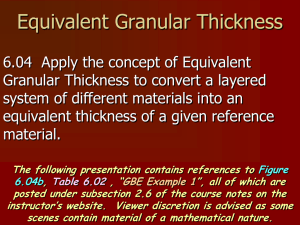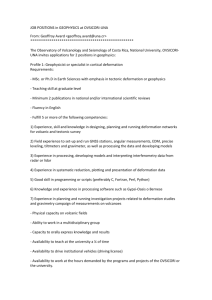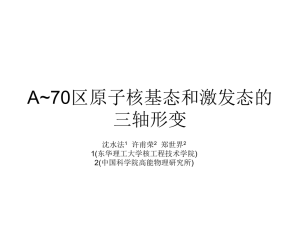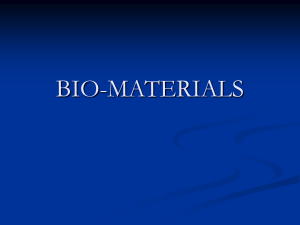Deformational properties of unbound granular pavement materials
advertisement
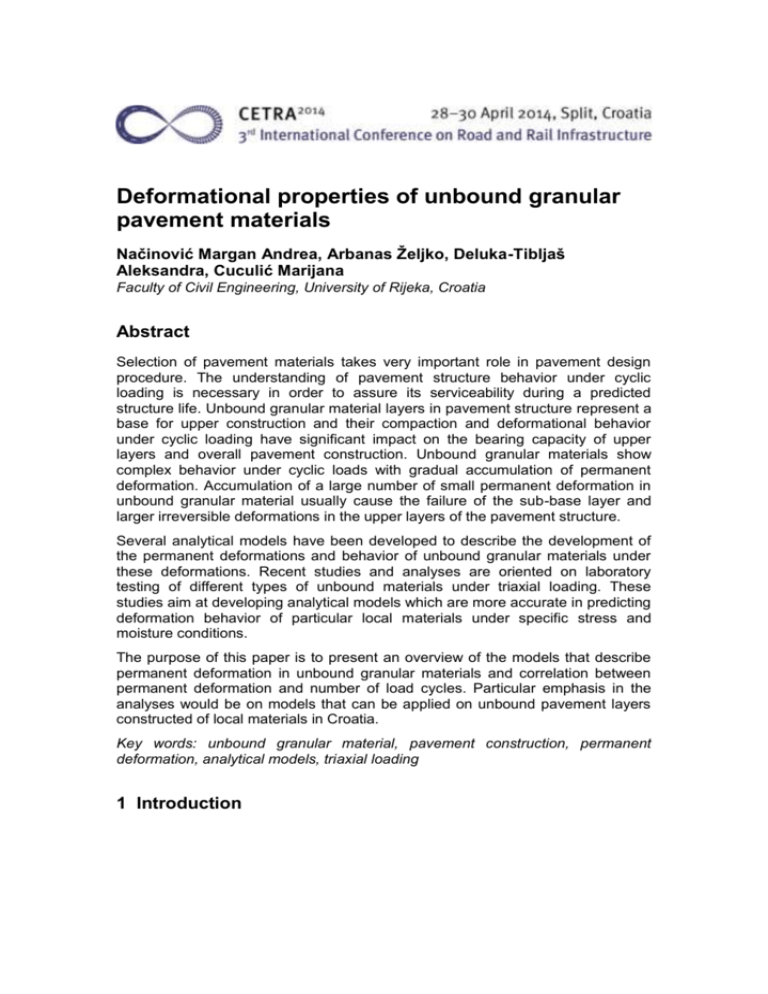
Deformational properties of unbound granular pavement materials Načinović Margan Andrea, Arbanas Željko, Deluka-Tibljaš Aleksandra, Cuculić Marijana Faculty of Civil Engineering, University of Rijeka, Croatia Abstract Selection of pavement materials takes very important role in pavement design procedure. The understanding of pavement structure behavior under cyclic loading is necessary in order to assure its serviceability during a predicted structure life. Unbound granular material layers in pavement structure represent a base for upper construction and their compaction and deformational behavior under cyclic loading have significant impact on the bearing capacity of upper layers and overall pavement construction. Unbound granular materials show complex behavior under cyclic loads with gradual accumulation of permanent deformation. Accumulation of a large number of small permanent deformation in unbound granular material usually cause the failure of the sub-base layer and larger irreversible deformations in the upper layers of the pavement structure. Several analytical models have been developed to describe the development of the permanent deformations and behavior of unbound granular materials under these deformations. Recent studies and analyses are oriented on laboratory testing of different types of unbound materials under triaxial loading. These studies aim at developing analytical models which are more accurate in predicting deformation behavior of particular local materials under specific stress and moisture conditions. The purpose of this paper is to present an overview of the models that describe permanent deformation in unbound granular materials and correlation between permanent deformation and number of load cycles. Particular emphasis in the analyses would be on models that can be applied on unbound pavement layers constructed of local materials in Croatia. Key words: unbound granular material, pavement construction, permanent deformation, analytical models, triaxial loading 1 Introduction Flexible pavement consists of one or more bound asphalt layer overlying one or more sub layers consisted of unbound granular material which are together compacted over a suitable soil subgrade and they are the most frequently used pavement type. It is well known that flexible road pavements over time deteriorate under effects of traffic load and weather. Because of that, selection of pavement materials takes very important role in pavement design procedure. The understanding of pavement structure behaviour under cyclic loading is necessary in order to assure its serviceability during a predicted structure life. Structure life of the pavement depends very much on the response and the quality of unbound granular layer material [1]. Unbound granular materials in sub-base and base layers have very important role in overall structural performance of the pavement and in general consisting crushed rock particles with certain amount of fines and water [7]. Unbound granular layers in pavement structure have complex elastoplastic response under traffic loading. In this paper the idea is to give a short overview of the existing models for the description of performance of unbound layers and materials. Basic analyses of the factors influencing that performance during time will be done too. 2 Permanent deformations and models that describe them Vehicles’ wheeling causes repeated cyclic loads on pavement structures and two types of deformation, resilient and permanent deformations, occus (Figure 1.). Resilient deformations are recoverable part of deformations and they are related to the fatigue cracking of overlying asphalt layers. Permanent deformations are irreversible, very important accumulated plastic, non-recoverable deformations which may lead to rutting, one of the principal failure of flexible pavement structures. Accumulation of a large number of small permanent deformation in unbound granular material during each loading cycle usually cause that failure, collapse of the sub-base layer and larger irreversible deformations like rutting in the upper layers of the pavement structure. These larger deformations accumulate during all service life [2,4,6]. Pavement design is made in the way that it can allow a very small number of a permanent deformation that does not threaten the stability of the pavements. Figure 1. Strains in Granular Materials during One Cycle of Load Application [4] Permanent deformation behaviour of unbound granular material is less studied than the resilient deformation because of influence of stress history, difficulties in correlating laboratory test results, of the complexity of the tests, complex and nonlinear constitutive relations of the materials [9,10]. The main and the best laboratory simulation of traffic loading method to test the deformation properties is cyclic load triaxial testing [5]. Repeated load triaxial apparatus is device for cyclic load triaxial testing on prepared cylindrical specimen in order to investigate the mechanical behaviour of unbound granular material. Similar stress like in the field can be simulate with triaxial apparatus on prepared specimen – a cyclic vertical stress σ1 and a cyclic horizontal stress σ3 after that the corresponding deformations are measured. Unbound granular material under cyclic loading expose elastoplastic behavior by increases permanent deformation with load repetitions [7,8,9,10]. Triaxial apparatus has a three controllers to generate back and air pressure and chamber in the partially saturated samples. Very important chamber is deaerated water [1]. With repeated load triaxial test more information can be obtain from a single specimen because the experimental dispersion is reduced as is the amount of time and materials required [10]. 2.1 Methods and models The older method that is used for describing permanent deformations is empirical traditional method. Traditional design methods are based on experience with certain types of pavement material. That approach has a lots of disadvantages and limitations because of increases in traffic loads and growing transportation needs that resulted in rapid deterioration of road networks. Because of that, nowadays, there is a strong desire to develop and study analytical methods and models to establish with more changes in loading and environmental conditions, construction techniques and materials [4]. Empirical models consider unbound granular material as linear elastic material with elastic moduli that is often determined on the empirical base [9]. Analytical models imply experimental approach application and mathematical characterization of behavior of unbound granular material under cyclic loading [3]. Models treat road pavement as a structure and they are based on analyzing the response of pavement layers and all structure under traffic cyclic load in certain environmental conditions [4]. The aim is to leave the traditional methods and develop an analytical models that best describe permanent deformation behaviour. Analytical approach requires understanding of the behaviour and properties of the materials. A large number of tests in laboratories can develop models that predict the permanent deformations. In laboratory it is possible to simulate the properties of material and response of unbound granular materials under cyclic traffic loading. Analytical pavement models can correlate deformations with layer thicknesses, layer material, conditions, traffic load which allows a prediction a value of permanent strain at any loading cycle at any stress [2,7]. Resilient response (Figure 1.) is non-linear and that deformations can be interpreted with several models like Uzans and k-θ models [3,5]. Irreversible, permanent deformations and strains are more complex and on their behaviour affect many factors like stress, number of load cycles, grain shape, stress history, density, mineralogy, water/moisture content, fines content, etc. [5]. 2.1.1 Impact of stress Stress has a significant influence on the permanent deformations in unbound granular layers. Stress similar to the stress in the field is simulated with triaxial apparatus. One of first significant conclusion that accumulation of axial permanent strain is related to deviator stress and confining pressure is given by Morgan (1966) [4]. Table 1. Equations that describe relationship between permanent strain and stress [13,14,15] Barksdale Pappin Paute 𝜀1,𝑝 = 𝑞/𝐾 ∗ 𝜎𝑛3 (𝑅𝑓 ∗ 𝑞)/2(𝐶 ∗ cos 𝜙 + 𝜎3 ∗ sin 𝜙) 1−[ ] (1 − sin 𝜙) 𝜀𝑠,𝑝 = (𝑓𝑛𝑁) ∗ 𝐿 ∗ ( 𝑞𝜊 𝑝 2.8 ) 𝜊 𝑚𝑎𝑥 𝑞𝑚𝑎𝑥 (𝑝𝑚𝑎𝑥 + 𝑝∗ ) 𝐴= 𝑞𝑚𝑎𝑥 𝑏 ∗ (𝑚 − (𝑝𝑚𝑎𝑥 + 𝑝∗ ) Barksdale [13] relates the permanent strain to the ratio of repeated deviator stress and constant confining pressure with equation in Table 1. Expression depends on apparent cohesion C, angle of internal friction ϕ, constants K and n and constant relating compressive strength to an asymptotic stress difference Rf. Pappin [15] also gives expression for accumulated permanent strain that depends on shape factor fnN, modified deviator stress q0 and modified mean normal stress p0, stress path length L. Also he declares that large permanent strains did not occur unless the material was stressed close to the static failure limit. At the University of Nottingham was carried out an experiment on five different specimens (aggregates) and none of listed equations and models seemed to give a satisfying explanation of the influence of stresses on accumulation of permanent deformation [7]. It was estimated that Paute [14] non-linear model (Table 1.) fits the data best at a low levels of shear stress ratio when the material have almost total resilient behaviour. The correlation with that model is relatively poor at high shear stress ratios when the accumulation of permanent deformations is progressive and cause deterioration [7]. Paute defines hyperbolic expression for limit value for maximum permanent axial strain (A). Limit value A increases when increases the maximum shear stress ratio and depends on parameters m (slope of the static failure line) and p⃰ (stress parameter defined by intersection of the static failure line and the p-axis in p-q space). Also depends on slope of static failure line m, maximum mean normal stress p max and regression parameter b [14]. 2.1.2 Effect of number of load applications, cycles Researchers also have followed another approach, trying to relate the permanent deformation with number of load applications. Number of load traffic cycles is very important factor for deterioration of pavements. Cyclic traffic loading is in laboratories also simulated with triaxial apparatus. In Table 2. is given overview of analytical models that offer the best expression for the correlation between strain and number of cycles [11,12,13,14]. Table 2. Equations that describe relationship between permanent strain and number of load cycles [11,12,13,14] Barksdale 𝜀1,𝑝 = 𝑎 + 𝑏 ∗ log(𝑁) Sweere 𝜀1,𝑝 = 𝑎 ∗ 𝑁𝑏 Khedr Paute et al. 𝜀𝑝 𝑁 = 𝐴 ∗ 𝑁−𝑚 𝑁 −𝐵 ∗ 𝜀1,𝑝 = 𝐴 ∗ (1 − ( ) ) 100 Every equation is obtained on the bases of test in triaxial apparatus on a few different specimen. Barksdale [13] gives equation after tests with 10 5 load applications where strain depends on number of cycles N and a and b, constants for a given level of σ1- σ3 and σ3. Swerre [12] also gives non-linear model but after 106 load cycles(N) that depends on regression parameters a and b. On Sweere model equation is based Korkiala-Tanttu model (Eqn. (1) [16]. 𝜀𝑝 (𝑁) = 𝐶𝑁 𝑏 𝑅 𝐴−𝑅 (1) Difference between Korkal-Tanttu and Sweere equation is in effect of stress levels based on classic soil mechanics. C and b in eqn (1) are material parameters and R is shear stress ratio q/q f., deviator stress/deviator stress at failure [8]. Khedr [11] presented model with conclusion that the rate of permanent strain accumulation decreases logarithmically with number of cycles where is m material parameter and A material and stress-strain parameter given as a function of shear stress ratio and resilient modulus. Together with previously experiment that studied influence of stress, on the same five specimens was carried out an experiment that studied effect of load cycles. Paute [14] non-linear model fit the data best and showed the least error in most cases in relation to others models that depends on number of cycles [7]. Paute model depends also on regression parameters A and B after 8x104 load repetitions. 2.1.3 Effect of moisture content Moisture is mostly related with the fines content of the material. Adequate amount of water doesn't have a negative influence on unbound granular material, but in the combination with rapidly applied loads lied to high pore pressure and saturation. The effective stress is reduce by that pore pressure and leads to reduction of permanent deformation resistance. Researches like Haynes, Barksdale, Dawson, etc. concluded that combination of low permeability due to bad drainage and high degree of saturation lead to low effective stress and high pore pressure that lead to low deformation resistance and low stiffness [4]. 2.1.4 Others Effects possible impacts Other parameters that effect on deformations are stress history (Brown and Hyde 1975), density (Barksdale 1972, Allen 1973, Holubec 1969), fines content (Barksdale 1972, 1991, Thom and Brown 1988), aggregate type (Allen 1973), grain shape (Barksdale and Itani 1989, Janoo 1998), surface texture, mineralogy. Also a few models give correlation between static and cyclic loading tests (Gerrard 1975, Lentz and Baladi 1981), between resilient and plastic behaviour (Veverka 1979) and correlation with permanent deformation moduli (Jouve 1987) [5,10]. 3 Local source for unbound granular layers in Croatia The aggregate type and mineralogy are very important parameters for unbound granular layers. Crushed rock for that use have to resist crushing under traffic loading. Unbound granular layers are mostly made of local materials. The construction of pavement structure can be accelerated if local materials is used and also the cost is much lower. In our region, aggregate used for pavement base and subbase is a crushed limestone aggregate that is local material with very good quality and parameters which are required in Technical Specifications [17]. Lekarp and Dawson study the permanent deformation behaviour of five different aggregates and one of this was crushed limestone. Test that depends on number of cycles load show that Paute model (Table 2.) fit the data best but not in a few cases. Test related with effect of stress also shows that Paute model (Table 1.) is the best model for limestone [6]. Khedr [11] was also studing crushed limestone with repeated load triaxial apparatus. The conclusion was that the rate of permanent strain accumulation decreases logarithmically with the number of load repetitions according to an equation 𝜀𝑝 𝑁 = 𝐴 ∗ 𝑁−𝑚 (2) Where m is a material parameter and A a material and stress-strain parameter gives as a function of shear stress ratio and resilient modulus. At the Universities of Perugia and Marche Polytechnic was investigated a crushed limestone aggregate through repeated load triaxial tests. They made a test with two mixtures, one was typical for unbound layers according to Italian Technical Specifications and second was combination of first with a silty clay soil fraction [2]. The results were analysed and compared with a few known models from Barksale, Sweere and Paute given in Figure 2. Also is given a new linearexponential model [2]: 𝜀𝑝 (𝑁) = 𝐴 + 𝐵 ∗ 𝑁 (3) A in eqn (3) is a constant expressing the variability of permanent strain accumulated during the first load cycles and B is the strain rate per load cycle. Figure 2. Design gradation for tested materials in reference band from Italy and Croatia [1,17] The determination coefficients R2 which are obtained for every model provide that the highest value have a last model – greater than 0,95 [2]. Gradation of materials that have been tested are located in reference band in Italy but also in reference band in Croatia (Figure 2.) and given model can be used for Croatians unbound layers although some more detailed analyses will help in estimating better permanent deformation behaviour in crushed limestone. 4 Conclusion In this paper an overview of the most used models for the determination of permanent deformation behavior in unbound pavement layers is given. It can be established that the impact of stress and the number of load cycles have the most important influence on unbound granular material deformation. All described analytical models that represent a relationship between stress and deformation depend on deviator and normal stresses. Each model also has different influence factors like cohesion, angle of internal friction, several constants, shape factor, stress path length and regression parameter. Results of the models???Models that relate the permanent deformation with the number of load cycles depend mostly on the number of load cycles. Every model has several parameters like regression, material, stress-strain parameter that also have a major impact on deformation. In the mentioned experiments that studied the impact of stress and the number of load cycles Paute model fits the data best. Crushed limestone is a local material in Croatia that is used in pavement structures. In this paper an overview of a few analytical models that can describe deformation behaviour in that material like Paute and Khedr model are presented. Also, a linear- exponential model is given that can be used for Croatian unbound layers because that model fits the data best with the determination coefficient greater than 0,95. Analytical models are very complex models because of the influence of a lot of parameters that have impact on deformation behaviour. It is necessary to conduct detailed analyses for crushed limestone locally used in Croatia also in order to establish detailed parameters for the pavement design. Reference [1] Perez, I., Medina, L. & Romana MG.: Permanent deformation models for a granular material used in road pavements, Construction and Building Materials, 20, pp. 790-800, 2006. [2] Cerni, G., Cardone, F., Virgili, A. & Camili, S.: Characterisation of permanent deformation behaviour of unbound granular materials under repeated triaxial loading, Construction ann Building Materials, 28, pp. 79-87, 2012. [3] Cuculić, M., Arbanas, Ž. & Deluka-Tibljaš, A.: Deformacijske značajke nevezanih zrnatih materijala, Zbornik radova, Građevinski fakulet, 12, pp. 232-253, 2009. [4] Lekarp , F., Isacsson, U. & Dawson, A.: State of the Art. II: Permanent strain response of unbound aggregates, Journal of transportation engineering, 126/1, pp. 76-83, 2000. [5] Uthus, L..: Deformation Properties of Unbound Granular Aggregates, Thesis for the degree of philosophiae doctor, NTNU, Trondheim, 2007. [6] Lekarp, F. & Dawson, A..: Analysis of permanent deformation behaviour of unbound granular materials, International Symposium on Thin Pavements, Surface Treatments, Unbound Roads, Canada, 1997. [7] Lekarp, F. & Dawson, A.: Modelling permanent deformation behaviour of unbound granular materials, Construction and Building Materials, 12, pp. 9-18, 1998. [8] Erlingsson, S. & Rahman, M.S.: Evaluation of Permanent Deformation Characteristics of Unbound Granular Materials from Multi-Stage Repeated Load Triaxial Test, TRB, 2013. [9] Hornych, P. & Absamad, A: Selection and Evaluation of Models for Prediction of Permanent Deformations of Unobund Granular Materials in Road Pavements, Publication SAM-05-DE10. s.l., Competitive and Sustainable Growth (GROWTH) Programme, 2004. [10] Gidel, G., Hornych P., Chauvin JJ., Breysse D. & Denis A., A new approach for investigating the permanent deformation behaviour of unbound granular material using the repeated load triaxial apparatus, Bulletin de Liaison des Laboratoires des Ponts et Chaussees, 233, pp. 5-21, 2001. [11] Khedr, S.: Deformation characteristics of granular base course in flexible pavement, Transportation Research Record, 1043, pp. 131-138, 1985. [12] Sweere, GTH.: Unbound granular bases for roads, PhD Thesis, University of Delft, 1990. [13] Barksdale, R.: Laboratory evaluation of rutting in base course materials, Proceedings of the Third International Conference on Structural Design of Asphalt Pavements, London, pp. 161-174, 1972. [14] Paute , J., Hornych, P. & Benaben, J.: Comportement mecanique des graves non traitees, Bull Liasion Laboratories Ponts Chaussees, 156, pp. 21-36.1988 [15] Pappin, J.W.: Characteristics of a granular material for pavement analysis, PhD. Thesis, Department of Civil Engineering, University of Nottingham, 1979. [16] Korkiala-Tanttu, L.: A New Material Model for Permanent Deformations in Pavements, Proceedings of the 7th Conference on Bearing Capacity of Roads and Airfields, Trondheim, Norway, 2005. [17]Opći tehnički uvjeti za radove na cestama, Hrvatske ceste – Hrvatske autoceste, Zagreb, 2001.

